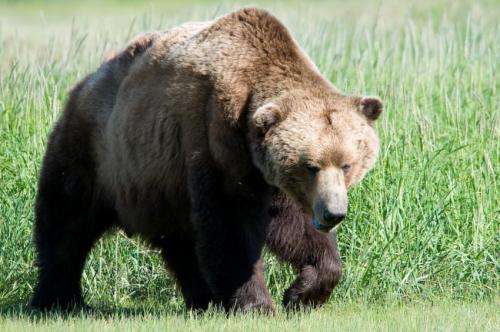November 14, 2014 report
Increase in bear infanticide linked to hunting

(Phys.org) —Studies conducted by multinational government and academic institutes have shown that bear hunting can indirectly increase cub mortality by 81 per cent.
The 21-year study focused on the movements of 180 female Scandinavian brown bears (Ursus arctos) over 13,000 km2 of rolling, forest landscape in south-central Sweden. The research was conducted primarily to investigate the population dynamics of large, long-lived mammals.
Bear hunting harvests in the area were monitored and the female bears were tagged with radio transmitter implants from 1990 to 2011. During the study, varying degrees of 'hunting pressure' were observed. Bear-hunting season lasts from late August or early September until October 15th or when the quota for a designated area has been reached. Only solitary bears, both male and female, are hunted. Family groups, including solitary cubs and yearlings, are protected from hunting. Female brown bears provide long periods of maternal care (between 1.5 and 4.5 years). The long periods of care reduce the availability of reproductive females.
Unlike their North American counterparts, Scandinavian brown bears have an increased propensity towards sexually selected infanticide (SSI). In cases of limited mating possibilities, it may be advantageous for a member of a sex (usually male) to eliminate the offspring of another member of the same sex to prompt a member of the opposite sex into a reproductive cycle. A female brown bear may become receptive only two to four days after losing her young during the mating season.
As expected, the bear population declined during times of high hunting pressure and grew under low hunting pressure . The analysis of the data indicated that the 2 percent decline in fecundity rates (reproductive rates of a population) was greater than expected, estimated after a period of high hunting pressure. Cub survival is important to population growth, with cub mortality reaching 81 percent over the course of the study. The cub loss is mostly attributed to SSI during mating season (mid-May to mid-July). The data showed that without SSI , and with other factors for survival being equal, cub survival would be 81percent higher. This illustrates that other factors besides hunting are responsible for the overall local population decline and that male behaviour appears to have an important effect on population dynamics.
The high hunting pressure resulted in 57 percent of males harvested in 2006–2011, compared with 52 percent in 1990–2005 (low hunting pressure). With more males bears killed, there was a higher likelihood of other male bears encountering cubs and females with cubs that are not related to the male, and thus SSI occurrence increased, causing the larger decrease in bear population.
Other indirect causes for the bear population decline due to hunting are also influenced by the male bear population. In order to counter SSI, female bears (with cubs) during the mating season avoid good habitats in favour of those in close proximity to humans. This has detrimental effect on the diet of the bear and could subsequently influence female reproductive output, lowering the fecundity.
The study hopes these new findings will be used when establishing hunting quotas and management policies.
More information: Gosselin J, Zedrosser A,Swenson JE, Pelletier F. 2015 The relative importance of direct and indirect effects of hunting mortality on the population dynamics of brown bears. Proc. R. Soc. B 282: 20141840. dx.doi.org/10.1098/rspb.2014.1840
(c) 2014 Phys.org














